How to clean a washing machine filter: a review of the best methods
The design of automatic washing machines includes elements such as drain and fill filters.They protect equipment from dirt and damage. In order for the filters to perform their functions, they are periodically cleaned.
Manufacturers recommend doing this once every six months. Once you figure out how to clean the filter in your washing machine, you can do it yourself, without professional support. Agree, such skills will save the family budget and allow you to solve the problem quickly, without waiting for the technician to arrive.
But before you start work, you need to study all the nuances of the process. We will tell you what causes the filter to quickly clog and how to understand that it is time to clean it. In addition, we will provide step-by-step instructions for removing contamination, and also list ways to prevent clogging of the filter device.
The content of the article:
Cleaning the drain filter
Using a drain filter, waste water is purified from various debris (coins, buttons, etc.). The filter element can become clogged due to the presence of impurities and heavy elements in the water.
Cleaning is necessary to prevent small organic and inorganic impurities from entering the pump and pipes, which can damage the parts.
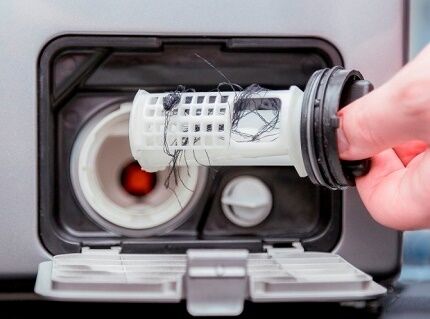
Signs that cleaning is needed
A drain filter is also called a drain filter, a waste filter, and a pump filter.
Signs indicating the need for the procedure are:
- termination of all functions;
- difficulty draining liquid, during which it slows down or stops completely;
- when switching to "Spin» the system turns off immediately;
- The “Rinse” function does not work.
Each of the listed signs is a signal to take action to clear the filter of debris.
Procedure sequence
Before removing the filter, you must stock up on a container for draining water and dry rags, covering the car with them and slipping them under the bottom. The fact is that even after draining, a certain amount of water remains in it. The rags will absorb the liquid and protect the floor from moisture.
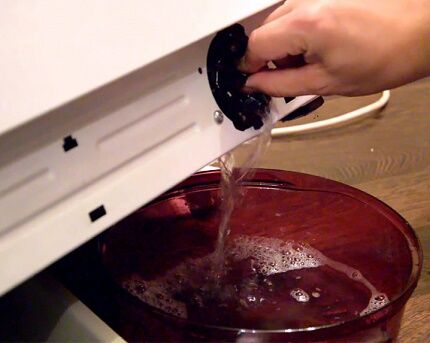
This is done because some models have components that cannot be disconnected from the power supply instantly. Once you are sure that the machine is completely turned off, you can start working. Before removal, the filter cover is unscrewed and pulled out of the socket.
After this, the following manipulations are carried out:
- Rinsing under running water.
- Cleaning contaminated areas with a brush.
- Cleaning from limescale and getting rid of unpleasant odor by soaking in a solution of citric acid and water.
The filter seat in the machine is also cleaned, as debris may get stuck in it. To make the procedure easier, use a flashlight to illuminate dark areas.
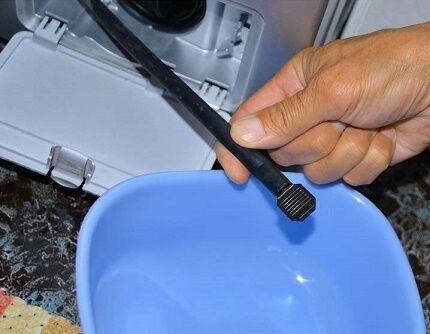
After removing debris and rinsing under running water, the clean part is installed in place.
Problems and solutions
When cleaning the filter element, you may encounter a problem. It consists in the fact that the lid does not turn.

In such a situation, if you have a car brand Indesit, lay the car on its side and remove the pump. If the model is without a cover, you will see the pump. If there is a cover, it must be removed. After this you need to disconnect the wires. Next, you will need to unscrew the bolts holding the part and detach the electrics from the pump.
The filter is then treated with WD-40 liquid, opened and cleaned. After completing the procedure, the steps are carried out in the reverse order. When screwing on the cap, pay attention to how tightly it is screwed on. A poorly screwed lid will let water through.
Machines of different brands and models have different characteristics, so before carrying out work, you must read the relevant section in the instructions. Knowing their features will help you avoid difficulties. For example, in washing machines whose filter is secured with a screw, you will need to first unscrew the screw.

If the design does not include a drainage filter, remove the washing machine body and check the volute, drain pump and pipes. Read more about disassembling units from different manufacturers in this article.
For cars like Samsung, Ariston And Indesit, the drain filter is located at the bottom on the front side. In models LG and Bosch it is located behind the decorative hatch on the lower right.
Cleaning the filler filter
Washing machines also have a filler filter element in the form of a mesh that does not allow foreign objects and impurities to enter. Such devices are not provided in all car models.
Signs of a clogged fill filter are:
- reduced pressure of water entering the machine;
- increasing washing time;
- The device works well, but when filling it hums and does not fill with liquid.
The element is connected to the inlet hose and is located near the water supply valve.

Step-by-step cleaning instructions
To fix the problem, you will need to clean the fill filter.
This is done in the following sequence:
- Before cleaning, turn off the water.
- The filler tube is removed, after which the filter mesh will be visible.
- The mesh is removed using pliers. This must be done carefully, as it is very fragile and can break.
- The extracted element is cleaned and washed with water.
- The clean filter is returned to its place and the hose is attached.
Models may differ in design, but the procedure remains the same.
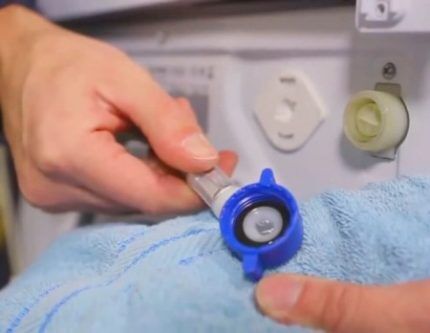
Particular attention is paid to the filter, which is usually located under the cover, within reach.
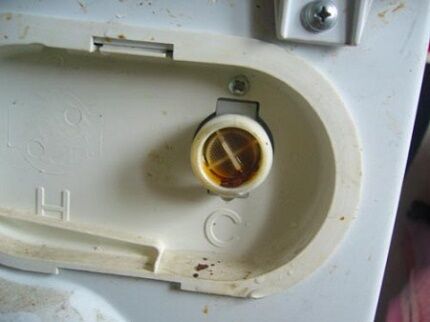
It is not possible to clean the filter located inside the washing machine body, so it must be removed.
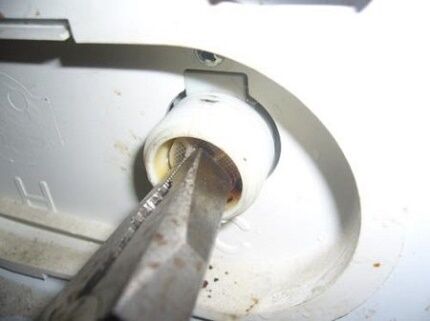
When using pliers, you need to be as careful as possible so as not to damage the filter.

The performance of the filter is affected by the quality of the water. The tougher it is and the more impurities it contains, the more often it will have to be cleaned. To ensure smooth operation of the machine, you can use special filters, additionally installed for washing machines.
Types of pollution and factors causing them
Before cleaning the filters, it is necessary to determine the type of contamination and the reasons for its occurrence. To prevent the formation of dirt, there are preventive methods and means. Knowing the causes, consequences and ways to eliminate the problem, you will extend the life of your machine and ensure its trouble-free operation.
In addition to the usual garbage that gets into the washing machine along with things, ordinary dirt, limescale, scale and mold deposits . There are different methods and available means to eliminate them. With their help, you will not only clean the filters, but also prevent the appearance of contaminants.
The reasons for filter contamination are:
- hard water;
- particles, lint, separated from washed items;
- untimely cleaning and drying of all machine elements;
- poor quality of powders and other detergents.
Let's look at the main types of pollutants and ways to eliminate them.
Poor quality water becomes one of the main reasons for the formation of scale and limescale on filters and other machine parts. For cleaning the washing machine can use professional and home remedies.
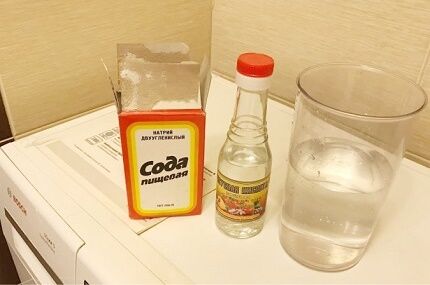
Professional tools are selected in accordance with the functional features of the device and your financial capabilities.
Whiteness is considered a simple and affordable remedy. Cleaning can also be done mechanically, but not independently, but with the help of specialists who use special devices for these purposes.
If dirt gets on the filter, pile from clothes, as well as untimely cleaning and the use of low-quality laundry detergents, deposits of dirt, mold and an unpleasant odor are formed. Cleaning is carried out, as in the first case, with home and professional means.

In addition to vinegar and citric acid, it is recommended to use copper sulfate and soda, as well as whiteness. After cleaning and finishing the rinsing cycle, all parts must be wiped with a clean, dry cloth and dried.
Folk remedies for caring for the unit
Let's look at the main products used to clean the drain filter and how to use them. These are proven effective methods that you can use to prevent and clean filters using simple DIY methods.
Application of citric acid
Citric acid is an affordable and cheap product that is odorless.
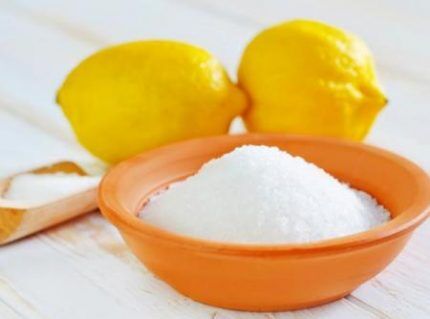
Rules using lemon juice:
- Pour 60-100 grams of acid into the powder container. The amount of product is determined by the length of time during which no cleaning was carried out.
- Turn on the device for a full cycle at a temperature of 60 degrees or more. The maximum temperature mode is chosen if the machine is heavily dirty.
- Remove dirt and acid residues by rinsing. If the machine is not completely cleaned, repeat the procedure.
Upon completion, the filter is cleaned of any remaining deposits.
The process of cleaning a washing machine using citric acid is demonstrated in the video:
Cleaning the filter with soda
Baking soda is an affordable solution for cleaning mold. Soda is used to clean all parts on which it forms.
Mode of application:
- Soda is diluted one to one with water.
- The fabric is moistened in a solution of water and soda.
- Use a soaked cloth to wipe moldy elements.
- After several hours, the wash is started.
- At the end of it, remove any remaining dirt manually.
The procedure can be repeated several times, depending on the degree of contamination.
Using table vinegar
When using it, not only mold and scale are removed, but also an unpleasant odor.
Mode of application:
- 200 ml of 9% vinegar is poured into the powder tray.
- Turn on washing at temperatures from 60 to 90 degrees.
- After filling the machine with hot water, pause for 1 hour.
- Continue washing until complete.
- Clean the filter from remaining contaminants.
Then wipe all surfaces with a clean, dry cloth and allow to dry.
The video demonstrates cleaning technology using vinegar:
Whiteness in the fight for purity
The product can be classified as both professional and home use. Simple and affordable, it has a pungent odor. Provides high-quality cleaning of the drain filter.
Method of use:
- White is poured into the container for filling the powder.
- Turn on the longest cycle with the highest temperature for 15–20 minutes, pause the machine and leave for 2 hours.
- Includes washing and rinsing.
- Start the rinse cycle again.
Finally, wipe the parts dry with a rag.
Use of copper sulfate
This is an excellent, easy to use, affordable, odorless product.
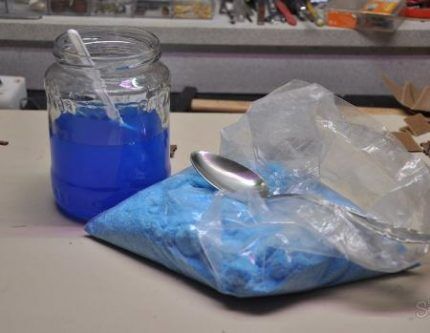
Instructions for use:
- The powdered substance (30 g) is diluted in 1 liter of water.
- Wipe all the insides of the car and leave it for a day.
- Start the wash with any washing powder.
As in other cases, turn on the additional rinsing program, and after cleaning, wipe with a dry cloth.
If you don’t want to do the “dirty” work yourself, you can call a plumber. Professional cleaning will eliminate the need to do work that is unusual for you.
Conclusions and useful video on the topic
You can learn how the cleaning process works in practice and how effective it is from the videos below.
Cleaning the water intake system filter:
How to clean the drain filter:
To summarize, we can say that the service life of an automatic washing machine depends on proper care. Cleaning can be done either independently or by calling specialists to your home. Do this at least twice a year.
It’s not difficult to figure out how and what to clean the filters with. To do this, you need to determine the type of contamination and the type of product that will help you remove it. Preventive methods available to every housewife are also effective. If you do not want to clean and launder your washing machine, call those who will do it efficiently and professionally.
Do you have anything to add or have questions about cleaning the drain and fill filter of your washing machine? You can leave comments on the publication, participate in discussions and share your own experience in removing contaminants from unit parts. The contact form is located in the lower block.




In principle, cleaning a washing machine filter is not very difficult, and most ordinary people can do it. The main thing is not to lead to an advanced situation when ordinary remedies like citric acid can no longer cope. But you shouldn’t run the machine with acid too often, as this can lead to damage to some parts. Plus, you should carefully select the dosage.
Cleaning the filter is really easy. First of all, you need to unplug the machine and turn off the water. Filters are usually placed at the front to make them easy to reach. You remove the lid and unscrew the filter, and of course, you wonder where the stones, small change, threads, etc. came from. That's what happened to me. But what they write correctly is to be sure to place a couple of rags under the machine and more near the filter itself. Water flows out of there normally.